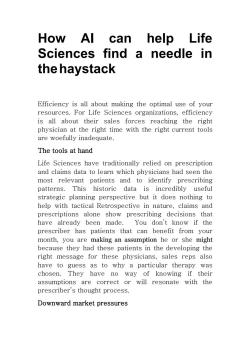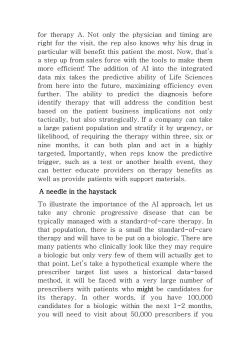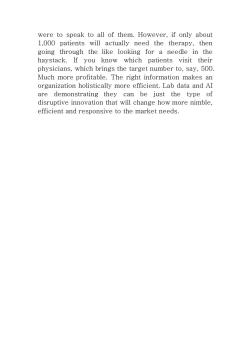上海交通大学:《探索物质微观世界》课程教学资源(辩论资料)How AI can help Life Sciences find a needle in thehaystack

How Al can help Life Sciences find a needle in the haystack Efficiency is all about making the optimal use of your resources.For Life Sciences organizations,efficiency is all about their sales forces reaching the right physician at the right time with the right current tools are woefully inadequate. The tools at hand Life Sciences have traditionally relied on prescription and claims data to learn which physicians had seen the most relevant patients and to identify prescribing patterns.This historic data is incredibly useful strategic planning perspective but it does nothing to help with tactical Retrospective in nature,claims and prescriptions alone show prescribing decisions that have already been made.You don't know if the prescriber has patients that can benefit from your month,you are making an assumption he or she might because they had these patients in the developing the right message for these physicians,sales reps also have to guess as to why a particular therapy was chosen.They have no way of knowing if their assumptions are correct or will resonate with the prescriber's thought process. Downward market pressures
How AI can help Life Sciences find a needle in thehaystack Efficiency is all about making the optimal use of your resources. For Life Sciences organizations, efficiency is all about their sales forces reaching the right physician at the right time with the right current tools are woefully inadequate. The tools at hand Life Sciences have traditionally relied on prescription and claims data to learn which physicians had seen the most relevant patients and to identify prescribing patterns. This historic data is incredibly useful strategic planning perspective but it does nothing to help with tactical Retrospective in nature, claims and prescriptions alone show prescribing decisions that have already been made. You don’t know if the prescriber has patients that can benefit from your month, you are making an assumption he or she might because they had these patients in the developing the right message for these physicians, sales reps also have to guess as to why a particular therapy was chosen. They have no way of knowing if their assumptions are correct or will resonate with the prescriber’s thought process. Downward market pressures

That's a lot of guesswork for the industry looking to increase sales while facing significant downward pressures in the market.Over the past 3-5 years,Life Sciences organizations had to operate in a changing managed care environment.Patients are often restricted access to high physicians have to take multiple administrative steps to demonstrate that a patient should,indeed,be on the therapy they consider the most efficacious.At the same time,some recent highly differentiated drug such as for high cholesterol or chronic heart failure,have not performed as well as expected.Moreover,the size of an average sales team has been shrinking in many companies.Today,you hardly ever see a 5,000 member sales force that can visit every prospective physician every month or quarter.opportunity to speak with physicians has diminished as some adopt a as little as a few minutes- to learn about the treatment options.This means that the time reps do get with prescribers needs to be spent wisely,with the message that will help physicians distract them from it. The game changer:applying AI to clinical lab data So,how do you improve sales reps'efficiency?With diagnostic,or lab,data and Artificial techniques.A lab result is the determining factor in about 70%of prescribing decisions.Used on its own or in combination with claims and prescription records,lab data allows for a de-identified patient patient journey to be mapped out.Clinical lab data indicates -in real time,as soon as the lab test results are ready -how a patient is doing,if he or she needs a specific therapy. This is the first time ever that Life Sciences can know that Dr.Smith currently has a patient who is a great fit
That’s a lot of guesswork for the industry looking to increase sales while facing significant downward pressures in the market. Over the past 3-5 years, Life Sciences organizations had to operate in a changing managed care environment. Patients are often restricted access to high physicians have to take multiple administrative steps to demonstrate that a patient should, indeed, be on the therapy they consider the most efficacious. At the same time, some recent highly differentiated drug such as for high cholesterol or chronic heart failure, have not performed as well as expected. Moreover, the size of an average sales team has been shrinking in many companies. Today, you hardly ever see a 5,000 member sales force that can visit every prospective physician every month or quarter. opportunity to speak with physicians has diminished as some adopt a as little as a few minutes – to learn about the treatment options. This means that the time reps do get with prescribers needs to be spent wisely, with the message that will help physicians distract them from it. The game changer: applying AI to clinical lab data So, how do you improve sales reps’ efficiency? With diagnostic, or lab, data and Artificial techniques. A lab result is the determining factor in about 70% of prescribing decisions. Used on its own or in combination with claims and prescription records, lab data allows for a de-identified patient patient journey to be mapped out. Clinical lab data indicates – in real time, as soon as the lab test results are ready – how a patient is doing, if he or she needs a specific therapy. This is the first time ever that Life Sciences can know that Dr. Smith currently has a patient who is a great fit

for therapy A.Not only the physician and timing are right for the visit,the rep also knows why his drug in particular will benefit this patient the most.Now,that's a step up from sales force with the tools to make them more efficient!The addition of AI into the integrated data mix takes the predictive ability of Life Sciences from here into the future,maximizing efficiency even further.The ability to predict the diagnosis before identify therapy that will address the condition best based on the patient business implications not only tactically,but also strategically.If a company can take a large patient population and stratify it by urgency,or likelihood,of requiring the therapy within three,six or nine months,it can both plan and act in a highly targeted,Importantly,when reps know the predictive trigger,such as a test or another health event,they can better educate providers on therapy benefits as well as provide patients with support materials. A needle in the haystack To illustrate the importance of the Al approach,let us take any chronic progressive disease that can be typically managed with a standard-of-care therapy.In that population,there is a small the standard-of-care therapy and will have to be put on a biologic.There are many patients who clinically look like they may require a biologic but only very few of them will actually get to that point.Let's take a hypothetical example where the prescriber target list uses a historical data-based method,it will be faced with a very large number of prescribers with patients who might be candidates for its therapy.In other words,if you have 100,000 candidates for a biologic within the next 1-2 months, you will need to visit about 50,000 prescribers if you
for therapy A. Not only the physician and timing are right for the visit, the rep also knows why his drug in particular will benefit this patient the most. Now, that’s a step up from sales force with the tools to make them more efficient! The addition of AI into the integrated data mix takes the predictive ability of Life Sciences from here into the future, maximizing efficiency even further. The ability to predict the diagnosis before identify therapy that will address the condition best based on the patient business implications not only tactically, but also strategically. If a company can take a large patient population and stratify it by urgency, or likelihood, of requiring the therapy within three, six or nine months, it can both plan and act in a highly targeted, Importantly, when reps know the predictive trigger, such as a test or another health event, they can better educate providers on therapy benefits as well as provide patients with support materials. A needle in the haystack To illustrate the importance of the AI approach, let us take any chronic progressive disease that can be typically managed with a standard-of-care therapy. In that population, there is a small the standard-of-care therapy and will have to be put on a biologic. There are many patients who clinically look like they may require a biologic but only very few of them will actually get to that point. Let’s take a hypothetical example where the prescriber target list uses a historical data-based method, it will be faced with a very large number of prescribers with patients who might be candidates for its therapy. In other words, if you have 100,000 candidates for a biologic within the next 1-2 months, you will need to visit about 50,000 prescribers if you

were to speak to all of them.However,if only about 1,000 patients will actually need the therapy,then going through the like looking for a needle in the haystack.If you know which patients visit their physicians,which brings the target number to,say,500. Much more profitable.The right information makes an organization holistically more efficient.Lab data and AI are demonstrating they can be just the type of disruptive innovation that will change how more nimble, efficient and responsive to the market needs
were to speak to all of them. However, if only about 1,000 patients will actually need the therapy, then going through the like looking for a needle in the haystack. If you know which patients visit their physicians, which brings the target number to, say, 500. Much more profitable. The right information makes an organization holistically more efficient. Lab data and AI are demonstrating they can be just the type of disruptive innovation that will change how more nimble, efficient and responsive to the market needs
按次数下载不扣除下载券;
注册用户24小时内重复下载只扣除一次;
顺序:VIP每日次数-->可用次数-->下载券;
- 上海交通大学:《探索物质微观世界》课程教学资源(补充材料)引力波_The advanced LIGO input optics.pdf
- 上海交通大学:《探索物质微观世界》课程教学资源(补充材料)引力波_A tool for measuring the bending length in thin wires.pdf
- 上海交通大学:《探索物质微观世界》课程教学资源(补充材料)引力波_Damping and local control of mirror suspensions for laser interferometric gravitational wave detectors.pdf
- 上海交通大学:《探索物质微观世界》课程教学资源(补充材料)引力波_Thermal effects in the Input Optics of the Enhanced Laser Interferometer Gravitational Wave Observatory interferometers.pdf
- 上海交通大学:《探索物质微观世界》课程教学资源(补充材料)XRD_High Contrast for Difficult-to-Image Materials.pdf
- 上海交通大学:《探索物质微观世界》课程教学资源(补充材料)XRD_High Contrast for Difficult-to-Image Materials.pdf
- 上海交通大学:《探索物质微观世界》课程教学资源(补充材料)XRD_Crystals_AsCA2012.pdf
- 上海交通大学:《探索物质微观世界》课程教学资源(补充材料)SCINCE_范艾伦带.doc
- 上海交通大学:《探索物质微观世界》课程教学资源(补充材料)SCINCE_不确定原理 Demonstrating Uncertainty.pdf
- 上海交通大学:《探索物质微观世界》课程教学资源(补充材料)A Long-Lived Relativistic Electron Storage Ring Embedded in Earth’s Outer Van Allen Belt.pdf
- 上海交通大学:《探索物质微观世界》课程教学资源(补充材料)Label-free nanoscopy of living cells.pdf
- 上海交通大学:《探索物质微观世界》课程教学资源(补充材料)Advances in multiphoton microscopy technology.pdf
- 上海交通大学:《探索物质微观世界》课程教学资源(补充材料)Dark-matter hunt gets deep.doc
- 上海交通大学:《探索物质微观世界》课程教学资源(课件讲义)第四讲 光的本质认识(饶群力).pdf
- 上海交通大学:《探索物质微观世界》课程教学资源(课件讲义)第十讲 透射电子显微镜.pdf
- 上海交通大学:《探索物质微观世界》课程教学资源(课件讲义)第十二讲 量子理论的发展.pdf
- 上海交通大学:《探索物质微观世界》课程教学资源(课件讲义)第十三讲 原子力显微镜技术.pdf
- 上海交通大学:《探索物质微观世界》课程教学资源(课件讲义)第十一讲 扫描电子显微镜技术.pdf
- 上海交通大学:《探索物质微观世界》课程教学资源(课件讲义)第六讲 X射线的发现与衍射技术.pdf
- 上海交通大学:《探索物质微观世界》课程教学资源(课件讲义)第八讲 同步辐射.pdf
- 上海交通大学:《探索物质微观世界》课程教学资源(文献资料)Electron tomography and holography in materials science.pdf
- 上海交通大学:《探索物质微观世界》课程教学资源(文献资料)Is science prepared for atomic-resolution electron microscopy.pdf
- 上海交通大学:《探索物质微观世界》课程教学资源(文献资料)Advances in multiphoton microscopy technology.pdf
- 上海交通大学:《探索物质微观世界》课程教学资源(文献资料)Near-edge X-ray absorption fine-structure microscopy of organic and magnetic materials.pdf
- 上海交通大学:《探索物质微观世界》课程教学资源(文献资料)Label-free nanoscopy of living cells.pdf
- 上海交通大学:《探索物质微观世界》课程教学资源(文献资料)obital reconstruction and covalent bonding at an oxide interface.pdf
- 上海交通大学:《探索物质微观世界》课程教学资源(Science)A Long-Lived Relativistic Electron Storage Ring Embedded in Earth’s Outer Van Allen Belt.pdf
- 上海交通大学:《探索物质微观世界》课程教学资源(文献资料)Structure and bonding at the atomic scale by scanning transmission electron microscopy.pdf
- 上海交通大学:《探索物质微观世界》课程教学资源(文献资料)X-ray imaging beyond the limits.pdf
- 上海交通大学:《探索物质微观世界》课程教学资源(coherent)X-ray diffraction imaging of strain at the nanoscale.pdf
- 上海交通大学:《探索物质微观世界》课程教学资源(science)不确定原理 Demonstrating Uncertainty.pdf
- 上海交通大学:《生态环境材料学 Ecomaterialogy》课程教学资源(课件讲稿)课程介绍、生态环境材料概述(孙宝德).pdf
- 上海交通大学:《生态环境材料学 Ecomaterialogy》课程教学资源(课件讲稿)生态环境材料(钢铁).pdf
- 上海交通大学:《生态环境材料学 Ecomaterialogy》课程教学资源(课件讲稿)生态环境材料(生态材料学).pdf
- 上海交通大学《生态环境材料学》:材料科学的一个新生长点——生态材料学.pdf
- 《生态环境材料学》课程教学资源:生态材料论(北京科技大学材:肖纪美).pdf
- 上海交通大学:《材料与社会 Materials & Society》课程教学资料(作业论文)玻璃与水晶.pptx
- 上海交通大学:《材料综合实验》课程教学学课件(讲稿)硬度教学.pdf
- 上海交通大学:《材料美学》课程教学资源(课件讲义)材料美学——古典性能美.ppt
- 上海交通大学:《材料美学》课程教学资源(课件讲义)隐身与防弹材料(宁月生).pptx
